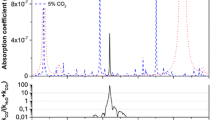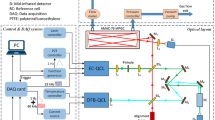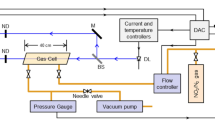Abstract
The development of a sensitive sensor for detecting nitric oxide (NO) emissions from biological samples is reported. The sensor is based on tunable diode laser absorption spectroscopy (TDLAS) using a continuous wave, thermoelectrically cooled quantum cascade laser (QCL) and a 100-m astigmatic Herriot cell. A 2f-wavelength modulation spectroscopy technique was used to obtain QCL-based TDLAS NO emission measurements with an optimum signal-to-noise ratio. An absorption line at 1,900.076 cm−1 was targeted to measure NO with a minimum detection limit of 124 ppt. Positive control measurements with the NO donor DETA NONOate were performed to determine and optimize the sensor performance for measurements of biological samples. Our measurements with NO donor show the potential suitability of the sensor for monitoring NO emission from cancer cells for biological investigations.






Similar content being viewed by others
References
D. Fukumura, S. Kashiwagi, R.K. Jain, Nat. Rev. Cancer 6, 521 (2006)
W. Xu, L.Z. Liu, M. Loizidou, M. Ahmed, I.G. Charles, Cell Res. 12, 311 (2002)
R. SoRelle, Circulation 98, 2365 (1998)
L. Thomsen, D. Miles, Cancer Metastasis Rev. 17, 107–118 (1998)
A.J. Hobbs, A. Higgs, S. Moncada, Annu. Rev. Pharmacol. Toxicol. 39, 191 (1999)
S. Mocellin, V. Bronte, D. Nitti, Med. Res. Rev. 27, 317 (2007)
S. Huerta, S. Chilka, B. Bona Vida, Int. J. Oncol. 33, 909 (1992)
American Cancer Society, Cancer facts and figures 2014 (American Cancer Society, Atlanta), www.cancer.org
C.A. Caneba, N. Bellance, L. Yang, L. Pabst, D. Nagrath, Am. J. Physiol. Endocrinol. Metab. 303, E1036 (2012)
S.A. Cannistra, N. Engl. J. Med. 351, 2519–2529 (2004)
R.C. Bast Jr., B. Hennessy, G.B. Mills, Nat. Rev. Cancer 9, 415–428 (2009)
L.L. Thomsen, F.G. Lawton, R.G. Knowles, J.E. Beesley, V. Riveros-Moreno, S. Moncada, Cancer Res. 54, 1352–1354 (1994)
J. Faist, F. Capasso, D.L. Sivco, C. Sirtori, A.L. Hutchinson, A.Y. Cho, Science 264, 553 (1994)
C. Gmachl, F. Capasso, D.L. Sivco, A.Y. Cho, Rep. Prog. Phys. 64, 1533 (2001)
Robert.F. Curl, F. Capasso, C. Gmachl, A.A. Kosterev, B. McManus, R. Lewicki, M. Pusharsky, G. Wysocki, F.K. Tittel, Chem. Phys. Lett. 487, 1 (2010)
A. Kosterev, G. Wysocki, Y. Bakhirkin, S. So, R. Lewicki, M. Fraser, F. Tittel, R. Curl, Appl. Phys. B 90, 165 (2008)
S. Barbieri, J.-P. Pellaux, E. Studemann, D. Rosset, Rev. Sci. Instrum. 73, 2458 (2002)
D.D. Nelson, J.H. Shorter, J.B. McManus, M.S. Zahniser, Appl. Phys B. 75, 343–350 (2002)
J.B. McManus, J.H. Shorter, D.D. Nelson, M.S. Zahniser, D.E. Glenn, R.M. McGovern, Appl. Phys. B 92, 387 (2008)
J.B. McManus, M.S. Zahniser, D.D. Nelson, Appl. Opt. 50, A74 (2011)
R. Lewicki, G. Wysocki, A.A. Kosterev, F.K. Tittel, Opt. Express 15, 7357 (2007)
S. Schilt, L. Thévenaz, P. Robert, Appl. Opt. 42, 6728 (2003)
S. Schilt, L. Thévenaz, Infrared Phys. Technol. 48, 154 (2006)
P. Werle, R. Mücke, F. Slemr, Appl. Phys. B. 57, 131 (1993)
J.A. Hrabie, J.R. Klose, D.A. Wink, L.K. Keefer, J. Org. Chem. 58, 1472 (1993)
L.K. Keefer, R.W. Nims, K.M. Davies, D.A. Wink, “NONOates” as nitric oxide donors: convenient nitric oxide dosage forms, in Nitric Oxide Part A: Sources and Detection of NO; NO Synthase, ed. by L. Packer (Academic Press, New York, 1996)
GE Water & Process Technologies, Analytical Instruments, Boulder, CO, www.geinstruments.com
Acknowledgments
The authors acknowledge Dr. C. Bauer from Testo AG, Germany, for providing the CW TEC DFB QCL.
Author information
Authors and Affiliations
Corresponding authors
Rights and permissions
About this article
Cite this article
Köhring, M., Huang, S., Jahjah, M. et al. QCL-based TDLAS sensor for detection of NO toward emission measurements from ovarian cancer cells. Appl. Phys. B 117, 445–451 (2014). https://doi.org/10.1007/s00340-014-5853-7
Received:
Accepted:
Published:
Issue Date:
DOI: https://doi.org/10.1007/s00340-014-5853-7




